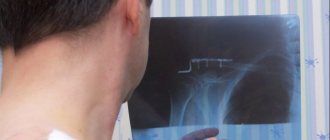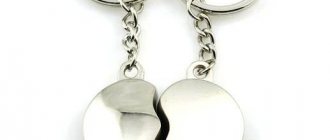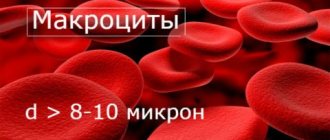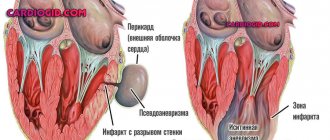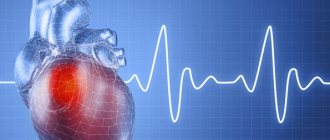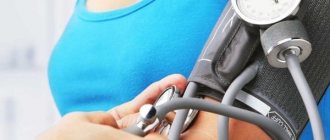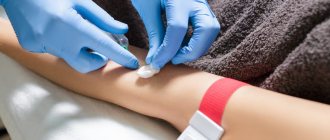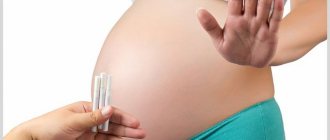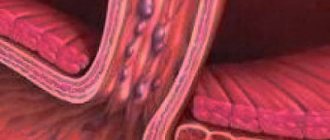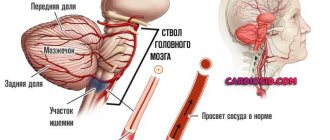Specific pain in the heart area - neurosis - is a consequence of functional disorders of the heart caused by mental disorders, for example, a hysterical state. Most often, such a pathology is observed in people with a weak, unstable psyche (especially melancholic people). Other pathologies associated with disorders of the central nervous system, as a result of which the tone of the nerve centers decreases, are also considered close to neurosis.
The mechanism of pathology development
The formation of a pathogenic phenomenon is based on a violation of the inhibition processes of the central nervous system; why this happens is a big question.
Tumor processes in the chiasmatic-sellar region or cerebral hemispheres are possible, hormonal imbalance, abnormalities in the thyroid gland, pancreas, and adrenal glands are possible.
The heart, despite all its autonomous functioning, does not exist in isolation. It is an integral part of the system. The frequency of contractions is regulated by hormones, as well as impulses from cerebral structures.
As a result of pathological excitation from the central nervous system, the signal reaches the cardiac structures. The sinus node begins to work more actively, producing electrical impulses that spur functional activity, hence the characteristic symptoms of cardioneurosis.
Against the background of a long course of the problem, organic changes begin. This is the result of wear and overload.
The best time for treatment is considered to be the first 3-4 years from the beginning. Then everything is much more complicated.
Causes
The factors in the formation of the pathological process are multiple. It is extremely rare that one moment takes part in the formation of a phenomenon; more often it is a group of triggers. Therefore, cardioneurosis can be called a polyetiological phenomenon.
Stressful situation
Momentary or long-term. Classic clinical variant. The patient is preparing for the exam; at the moment of climax, that is, the actual passing of the test, vegetative manifestations, as well as fainting, and disturbances in the functioning of the heart may occur.
For the most part, this is a safe phenomenon; in extremely rare situations, acute coronary insufficiency can occur. But for this there must be prerequisites: weakness of the sinus node, atherosclerosis, congenital or acquired heart defects.
Sometimes in this dangerous way the patient finds out that something is wrong with his health. First aid is provided on site or in a hospital.
Complications from the nervous system are possible, but not fatal, completely reversible. The prospects for a cure are vague, but you can change your lifestyle to prevent the development of repeated attacks.
Puberty
Puberty is the most dangerous period. The hormonal background is extremely unstable, changes occur.
Blood pressure fluctuates, heart rate is also unstable. Deviations in the functioning of the central nervous system are possible. A similar complex of factors makes neurosis of the heart muscle a probable phenomenon.
Depending on the type of accentuation, the condition can constantly recur in adulthood; the role here is played by the characteristics of higher mental activity and the type of temperament. During the most dangerous periods, regular examinations by a cardiologist and related specialists are indicated.
Pregnancy
Throughout gestation, various problems with the cardiovascular and nervous systems are possible.
This is relatively normal if there are no dangerous signs or complications. You need to carefully monitor your well-being, since there is a risk of missing late toxicosis and pathologies of cardiac structures of an organic nature.
This phenomenon does not require treatment, but should be observed regularly. Stressful situations that accompany neurosis have a negative impact on the health of the mother and fetus.
Menopause
Both in women and men (the so-called andropause). During the process, the level of specific hormones drops, and degenerative phenomena begin in the body. They affect the whole body, it's inevitable.
Regular preventive examinations are recommended under the supervision of at least a neurologist and a specialist in cardiac problems, as well as a psychotherapist.
The hormonal imbalance is corrected by another doctor, the situation will not be radically improved, the changes are cosmetic. If I may say so. But the risk of death and organic disorders is reduced.
Severe psychological trauma
Cardiac neurosis is not a purely cardiac condition. This is a complex of manifestations more from the central nervous system. In the presence of certain accentuated character traits, attacks, so-called panic attacks, are possible.
Less commonly, these same episodes are caused by functional pathologies. Therefore, the approach to treatment is differentiated. The basis is the use of psychotropic drugs and cognitive behavioral therapy.
It makes sense to take a full course of Ericksonian hypnosis under the supervision of a competent specialist.
Fatigue, severe psycho-emotional overload
Workaholics are at greater risk. In most cases, manifestations do not appear immediately; their full development takes from several weeks to a couple of months.
But with constant living in this mode, the body cannot stand it. It’s only a matter of time before cardioneurosis or something more dangerous happens. Depends on the strength of the body and psyche of a particular patient.
The condition can be treated simply - you need to normalize your work schedule, rest more and not overwork. Against the background of a long course of cardioneurosis, organic disorders are possible.
Insomnia
As a result of the same work, the examination period, and other factors. Also somatic diseases.
The nervous system is not able to function without a kind of daily reboot, which occurs during the period of night rest.
The condition is corrected with mild sedatives or sleeping pills. It is better to consult a somnologist, or, as a last resort, a specialist in the nervous system.
Business trips
Associated with changes in time zones and climatic conditions. Classic option.
Often such patients suffer from interruptions in the functioning of the heart, shortness of breath, attacks of fear for no reason and other phenomena of a vegetative nature.
Few people pay attention seriously. This is the first call. This is how the body reacts to a stressful situation, adaptation occurs in different ways. It takes several days.
If business trips or relocations are rare, there are no risks. Otherwise, you need to wait for problems of a cardiac nature.
With a busy work schedule and frequent changes of location, regular consultations with a cardiologist are recommended.
Depressive states
Not blues, as this term is usually understood, but a clinical diagnosis with a decrease in the level of endorphins and other hormones of cerebral structures.
Smoking, alcoholism, especially the use of drugs
The chances of recovery in this case are slim. Because it's hard to break a habit.
Against the backdrop of long-term use of active agents, more severe pathologies appear; cardioneurosis, in comparison, is a mild problem.
Interesting:
Cardioneurosis is not an organic pathology, that is, in the early stages, there are still no deviations in the anatomical structure of the heart. All transformations are a consequence of long-term overload of structures.
It's not worth bringing it to this point. Moreover, it may take more than one decade for serious problems to arise.
Types of arrhythmia
An abnormal heartbeat is an arrhythmia. There are such types of it:
- Tachycardia – increased heart rate.
- Bradycardia – low heart rate.
- Extrasystole is a single powerful contraction of the ventricles or atria.
- Atrial fibrillation is numerous chaotic superficial contractions of the atria that spread to the ventricles.
Each of these types occurs in VSD. All of them are characterized by disruption of the heart, poor blood supply to all organs and tissues of the body. This leads to their similar symptoms and treatment methods.
Extrasystole
Characteristic manifestations of extrasystoles are single heart beats of increased power (extrasystoles), which do not fit into the normal rhythm. Before the generation of an extrasystole impulse during VSD, an unpleasant sensation of cardiac arrest may appear. After a pause, the heartbeat starts again, but there is a more powerful beat than usual. This is how the built-in defibrillator works. Such fading can also occur with bradycardia.
- weakness;
- pallor;
- sweating;
- fear;
- feeling of lack of air.
Remember the reasons for the appearance of VSD: one of the sources of the syndrome is long-standing stress that needs treatment, which daily and imperceptibly torments the consciousness. If you don’t get rid of them, the brain will accumulate negative energy. Then this negativity breaks out of the captivity of thoughts and, like lightning, strikes the heart or other organs.
Atrial fibrillation
This is characterized by a superficial twitching heartbeat (fibrillation): 350-700 pulses per minute. This is reminiscent of a nervous trembling of the body. Fibrillations are caused by experiences that you do not feel, having become accustomed to them. But you shouldn’t put up with this: immediate treatment is necessary.
Atrial fibrillation: many symptoms have been adopted from bradycardia:
This is combined with discomfort in the heart area.
Tachycardia
Tachycardia with VSD is the opposite of bradycardia and is expressed in rapid heartbeat in the absence of physical activity: more than 90 beats per minute.
The brain is designed in such a way that it controls the entire body and itself. Therefore, the invisible boss in the form of a controlling thought regularly passes through all the nooks and crannies of the cerebral hemispheres. When it comes across areas damaged by stress, the instinct of self-preservation is triggered: the body tries to mobilize to fight an invisible enemy. But the signs of danger are blurred. Therefore, mobilization is limited to incomprehensible excitement and increased heart rate.
Tachycardia with VSD may be accompanied by the following symptoms:
- heat on the face and throughout the body;
- increased sweating;
- lack of air;
- weakness;
- pulsation in the head;
- pain in the left side of the chest;
- panic state.
Over time, everything returns to normal without treatment.
Bradycardia
A significant slowdown in heart rate occurs with bradycardia:
- Less than 40 beats per minute - while awake.
- Less than 30 beats per minute - during sleep.
Bradycardia has the following symptoms:
- dizziness;
- weakness;
- lethargy;
- drowsiness;
- decreased temperature of the extremities.
To get rid of some symptoms of bradycardia or smooth them out, you can drink one cup of coffee daily. This will only give a temporary effect and not for every organism.
The main treatment for bradycardia, as well as other types of arrhythmia in VSD, is to eliminate the causes of vegetative-vascular dystonia syndrome.
Characteristic symptoms
There are no typical manifestations. Signs are noted from the nervous, cardiovascular systems, as well as the patient’s psyche.
It is not difficult to determine the clinical picture; anamnestic data is sufficient. If an acute period is recorded, there is no doubt at all.
An approximate list of symptoms:
- Headache. Sharp, squeezing. May vary in intensity. Against the background of a parallel increase in blood pressure, a stroke is likely. Therefore, help at the time of an attack should be immediate.
- Vertigo. The patient cannot normally navigate in space. The man falls. It is necessary to support the patient; injuries are possible.
- Darkening of the eyes, visual impairment.
- Noise in ears.
- Fainting as a symptom of cardioneurosis occurs in 80% of cases. As a result of an acute attack, the patient loses consciousness. You can restore the situation with the help of ammonia. Repeated episodes indicate cerebral ischemia, which can be dangerous.
- Tachycardia. Increased heart rate over a wide range. Paroxysms are possible, which is the most dangerous. In such a situation, the type of attack must be assessed. If it is ventricular, hospitalization and specialized treatment in several areas are necessary.
- Arrhythmia of a different origin. Atrial fibrillation, extrasystole. They are rare, but they pose a danger to life and health. Restoration of normal heartbeat under the supervision of a cardiologist and related doctors. Mandatory cardiography, blood pressure measurement and assessment of general status are indicated.
- Weakness, drowsiness due to ischemia of cerebral structures.
- Apathy. In approximately 30% of cases, patients become indifferent, sit or lie, and are reluctant to make contact. This is a consequence of an attack.
- In the remaining 70% of clinical situations, the picture is exactly the opposite. Motor excitement coexists with fear. A person literally rushes about, cannot find a place for himself. It may be dangerous. The patient is inadequate.
Symptoms of cardiac neurosis are nonspecific; infarction and angina pectoris manifest themselves in the same way. Objective methods put an end to the question. Delimitation in a short time. Possible on an outpatient basis.
Diagnostic measures
There are no unambiguous methods for diagnosing cardiac neurosis; a diagnosis can only be reached by exclusion.
The polysymptomatic nature of the disease can confuse the doctor during the examination process.
Worth seeing: Phobic neurosis
First of all, all other pathologies with a similar symptomatic picture should be excluded (ischemia, heart disease, heart attack, myocarditis, diseases of the respiratory system, gastrointestinal tract).
For this you need:
- personal appointment with a cardiologist, medical history, examination;
- ECG;
- Echocardiography;
- 24-hour ECG holder monitor;
- remote cardiac monitor;
- cardio stress tests.
If you have symptoms of cardioneurosis, you should see a cardiologist
Heart neurosis can be considered confirmed if:
- no pathologies of the cardiovascular, digestive, or respiratory systems were identified;
- it is possible to trace the dependence of the occurrence of crises on stress and psychological stress;
- visiting a psychotherapist and taking sedatives have a positive effect on the patient’s condition.
Diagnostics
The examination of patients is carried out initially by a group of specialists. The presenter is a neurologist. The rest are connected as needed.
Doctors whose competence includes assessing the functioning of cardiac structures are second in importance. In tandem, they identify the root cause of the condition and differentiate pathologies.
The scheme is as follows:
- Questioning the patient, collecting anamnesis. To determine the origin of a process. This is the main method of early diagnosis.
- Blood pressure measurement. As a rule, it is normal. Against the background of the course of concomitant pathologies - changed.
- Heart rate assessment. Tachycardia is the most likely option. If you find an acute condition, deviations are obvious even without special diagnostic methods.
- Daily monitoring. An attack is determined by an automatic tonometer as an area of increased blood pressure and heart rate. The study is possible both in an inpatient and outpatient setting, which is preferable due to the patient being in a familiar environment.
- Electrocardiography. To assess functional abnormalities of cardiac structures. The changes, meanwhile, are minimal. Arrhythmias are clearly visible.
- Echocardiography. To exclude organic transformations or congenital or acquired developmental defects.
- A general blood test and for hormones of the thyroid gland, pituitary gland, and adrenal cortex.
- Load tests. With great caution, if there is no suspicion of serious diseases of the cardiovascular system.
- Electroencephalography.
- Assessment of neurological status.
In the absence of evidence for organic changes, consultation with a psychiatrist is indicated. It is also used in case of ineffective treatment.
During the examination (several visits are required), a series of tests are performed to determine the patient’s psychotype and possible disorders of higher nervous, mnestic, and cognitive activity.
In the presence of a pronounced profile component, differential diagnosis with neurotic, anxiety disorder, bipolar affective state, and sluggish schizophrenia is indicated.
Clinical depression of various types is possible. Verification within several weeks, against the backdrop of an approximate therapeutic course.
First aid at home
To relieve an attack at home, you need to follow simple steps:
- Measure blood pressure. Also heart rate. Deviations of indicators are possible. Which in itself is dangerous. In such a situation, you need to call an ambulance.
- Open windows and vents to ensure the flow of fresh air into the room.
- Lay the patient down or sit him down; if there is shortness of breath, you should not take a horizontal position; it will probably worsen.
- Give valerian and motherwort tablets to drink (alcohol tincture excites the nervous system, this is unnecessary).
- You can take phenobarbital (Corvalol or Varocordin). They calm down and normalize the functioning of the heart, if there are no organic problems.
- Breathing techniques are also used to restore cardiac activity.
- In case of loss of consciousness, the patient's head must be turned to the side and the tongue released to avoid complications.
Now you should observe the person’s condition. With stabilization, we can talk about the success of the initial measures.
A convenient opportunity should be used to visit a cardiologist. The ambulance also provides assistance on site. Less often hospitalizes the patient.
Prevention
To prevent the appearance of heart neurosis, a person should:
adhere to a daily routine, proper nutrition; sleep long enough; spend more time outdoors; work on your temperament, for example, attend special courses to strengthen your character.
By getting rid of bad habits, a person will not only prevent the occurrence of heart neurosis, but also many other diseases. Thanks to regularly scheduled visits to the clinic, various diseases can be diagnosed in a timely manner, including those that may have cardiac neurosis as a complication.
Have you ever experienced manifestations of heart neurosis? Have you been diagnosed with this disease? Tell us about your illness in the comments.
Treatment methods
Curation is mixed. Since organic disorders are rare and develop as a consequence of cardioneurosis, their elimination is not the subject of discussion.
Medicines and psychotherapeutic techniques are used. The way of life is changing.
Preparations:
- Calming or sedative based on herbal ingredients. Such as motherwort, valerian, others.
- Phenobarbital in various pharmaceutical forms.
- Tranquilizers in difficult clinical cases. Diazepam and analogues. In a strictly adjusted dosage for a short period of time. Not suitable for long-term use.
- Mood stabilizers, antipsychotics. In extreme cases.
- General strengthening drugs. Based on potassium and magnesium.
As needed, antihypertensive and antiarrhythmic medications.
Psychotherapy:
- Ericksonian hypnosis.
- CBT. Allows you to control emotions, develop useful behavioral patterns and reactions, which reduces anxiety, prevents unnecessary stress and overexertion.
Treatment of cardiac neurosis can be carried out using folk remedies:
- Tea based on motherwort and valerian. Prepared in any way. Take a glass or two per day.
- Chamomile plus St. John's wort and peppermint. The creation method is identical. Consumption in the amount of 1 glass 2-3 times a day.
- Calamus, saffron in decoction form.
- Horse chestnut has high-quality cardiac properties. Prepare a tincture (300 grams per 500 ml of vodka, 2 weeks in a cool, dark place). Take 40 drops a day half an hour before breakfast or lunch.
Lifestyle changes play the biggest role:
- Quitting smoking, alcohol, and drugs even more so.
- Normalization of sleep (8 hours per night).
- Physical activity: walking, beginner cycling, swimming,
- Exercise therapy. The duration is arbitrary.
- Diet correction. More vitamins, protein, less carbohydrates, fatty foods, fried foods. Treatment tables No. 3 and No. 10 are shown, changing the menu at your discretion.
- Avoid stress whenever possible. This is the main point, since the load on the nervous system is a trigger factor.
The recovery period can take up to a year or two. As a rule, when using a set of techniques, attacks become less frequent and recovery is achieved faster.
Arrhythmia with VSD - is it dangerous and how to deal with it?
Arrhythmic syndrome with VSD does not pose a threat to life. However, it is necessary to undergo a medical examination in order to identify the cause of the irregular rhythm and accompanying unpleasant symptoms. In some cases, relaxation and proper rest help normalize heart contractions during arrhythmia. If pain is severe, you may need to take medications. Sedatives that relieve panic attacks and normalize a person’s psychological state are considered effective.
If arrhythmia is a pronounced symptom of VSD, then to completely eliminate attacks it is necessary to take comprehensive measures aimed at treating the underlying pathology. Therapeutic methods may include:
- psychotherapy;
- physiotherapy;
- taking medications, including antidepressants, sedatives, neuroprotectors for cerebral circulation;
- taking vitamins;
- massage;
- proper sleep and rest;
- proper nutrition, which means limiting the consumption of sweets, salt, fatty foods, including vegetables, fruits, and water in the diet.
An important point in the treatment and prevention of pathology is the way of thinking. It is necessary to learn to track negative thoughts and emotions and replace them with positive ones. Conscious concentration on something pleasant helps overcome stress.
Working with the body allows you to remove clamps and blocks. For this reason, daily moderate physical activity should become a habit.
